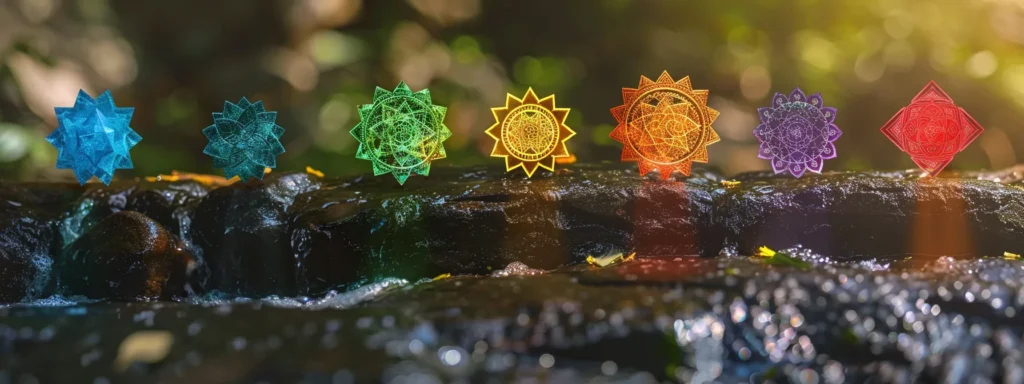Rudraksha Therapy
Unlocking the Symbolism and Significance of Chakra Icons
Table Of Contents:
- Key Takeaways
- Understanding the Origins of Chakra Symbols
- The Seven Major Chakra Icons and Their Meanings
- Color Significance in Chakra Icons
- Interpreting Shapes and Elements in Chakra Icons
- How Chakra Symbols Influence Energy and Healing
- Incorporating Chakra Icons Into Daily Practice
Are you curious about the deeper meanings behind chakra icons? Understanding these symbols can enhance your connection to your subtle body and promote healing. In this post, we will explore the origins of chakra symbols, the significance of the seven major chakra icons, and how colors and shapes influence their meanings. By engaging with this content, you will gain insights into how these symbols can foster unconditional love and balance in your life, helping you address any confusion or misconceptions you may have about their role in energy work.
Key Takeaways
- Chakras are vital energy centers influencing physical, emotional, and spiritual well-being
- Each chakra has unique symbols and colors that represent specific qualities and attributes
- Engaging with chakra symbols can enhance personal growth and emotional clarity
- Practices like meditation and yoga can activate and balance your chakras effectively
- Incorporating chakra imagery into daily life fosters mindfulness and supports overall well-being
Understanding the Origins of Chakra Symbols
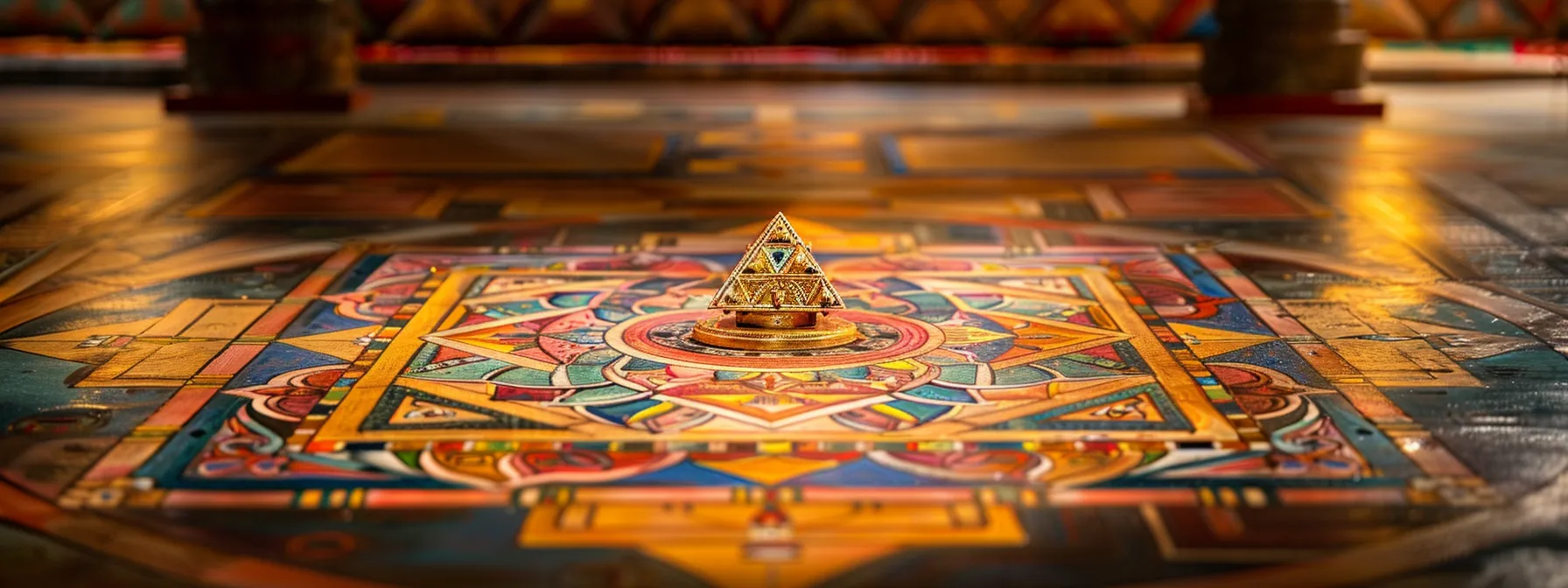
The historical background of chakras reveals their deep roots in ancient healing practices, where they were seen as vital energy centers supported by 7 chakra rudraksha. Cultural influences shaped chakra iconography, leading to unique representations in various traditions. Early depictions and manuscripts, including yantras, illustrate the connection between chakras and higher consciousness, mental health, and desire, particularly within the Vajrayana tradition. This section will explore these aspects in detail.
Historical Background of Chakras
The concept of chakras has its origins in ancient Indian traditions, where they were recognized as essential energy centers within the body. These centers are often depicted using various symbols, including the crescent shape and 7 chakra rudraksha, which represents the flow of energy and creativity. Understanding these symbols can help you connect with your inner self and promote harmony in your life.
Throughout history, chakras have been associated with different elements and qualities, often represented through alchemical symbols. For instance, the use of 7 chakra rudraksha crystals in chakra healing emphasizes the importance of these energy centers in achieving balance and well-being. By exploring these connections, you can gain insights into how to harness your own energy for personal growth and transformation.
The Vajrayana tradition, in particular, has contributed significantly to the visual representation of chakras, including the 7 chakra rudraksha. Early manuscripts and yantras illustrate the intricate relationship between chakras and higher consciousness. By studying these symbols, you can deepen your understanding of how they influence your mental health and desires, guiding you toward a more fulfilling life.
Cultural Influences on Chakra Iconography
Cultural influences play a significant role in shaping the iconography of chakras. Different traditions have contributed unique interpretations of chakra colours and symbols, reflecting their beliefs and practices. For instance, in some spiritual practices, the pituitary gland is associated with the third eye chakra, symbolizing intuition and insight, which highlights the interconnectedness of physical and spiritual well-being. Incorporating 7 chakra rudraksha can further enhance this balance.
The representation of chakras and 7 chakra rudraksha varies across cultures, with each symbol carrying its own meaning and significance. In Hinduism and Buddhism, the colours associated with each chakra often correspond to specific emotions and states of being. Understanding these chakra colours and symbols, including 7 chakra rudraksha, can enhance your spiritual practice, helping you to cultivate peace and balance in your life.
As you explore the cultural dimensions of chakra iconography, including the 7 chakra rudraksha, you may find that these symbols resonate with your personal experiences and aspirations. By engaging with the rich history and diverse interpretations of chakras, you can deepen your connection to these energy centers, fostering a greater sense of harmony and purpose in your journey toward self-discovery and growth.
Early Depictions and Manuscripts
Early depictions of chakra symbols can be found in ancient manuscripts that illustrate the connection between these energy centers and the universe. These texts often highlight the role of prana, or life force, in personal development and spiritual growth, including the 7 chakra rudraksha. By studying these early representations, you can gain insights into how chakras influence your confidence and overall well-being.
Manuscripts from various traditions showcase the intricate designs of chakra symbols, including the 7 chakra rudraksha, each carrying unique meanings that resonate with the soul. For example, the alignment of chakras is often depicted in yantras, which serve as visual tools for meditation and self-discovery. Engaging with these symbols can help you tap into your inner strength and foster a deeper connection with your spiritual journey.
As you explore these early depictions, you may notice how they reflect the beliefs and practices of their time. The symbolism embedded in these manuscripts serves as a guide for understanding the flow of energy within you. By recognizing the significance of these chakra icons and the 7 chakra rudraksha, you can enhance your personal development and cultivate a more harmonious existence:
Role of Chakras in Ancient Healing Practices
Chakras play a vital role in ancient healing practices, particularly within the frameworks of Buddhism and Hinduism. These energy centers, such as the muladhara or root chakra and 7 chakra rudraksha, are believed to influence physical, emotional, and spiritual well-being. By understanding the significance of these chakras, you can tap into their healing potential and promote balance in your life.
In the pursuit of enlightenment in Buddhism, the alignment and activation of chakras are essential. Each chakra corresponds to specific qualities and states of being, guiding you toward greater self-awareness and personal growth. For instance, the chakra color blue meaning is often associated with communication and expression, highlighting the importance of clear dialogue in your relationships and inner thoughts. Incorporating 7 chakra rudraksha can further enhance this balance.
Engaging with the symbolism of chakras, including the 7 chakra rudraksha, can enhance your healing journey. By focusing on the energy flow within these centers and incorporating the 7 chakra rudraksha, you can cultivate knowledge and insight that supports your overall health. This understanding empowers you to address any blockages or imbalances, leading to a more harmonious existence and a deeper connection to your spiritual path.
Now that you grasp the roots of chakra symbols, it’s time to explore the seven major icons. Each one holds a unique meaning that can deepen your understanding of energy and balance.
The Seven Major Chakra Icons and Their Meanings
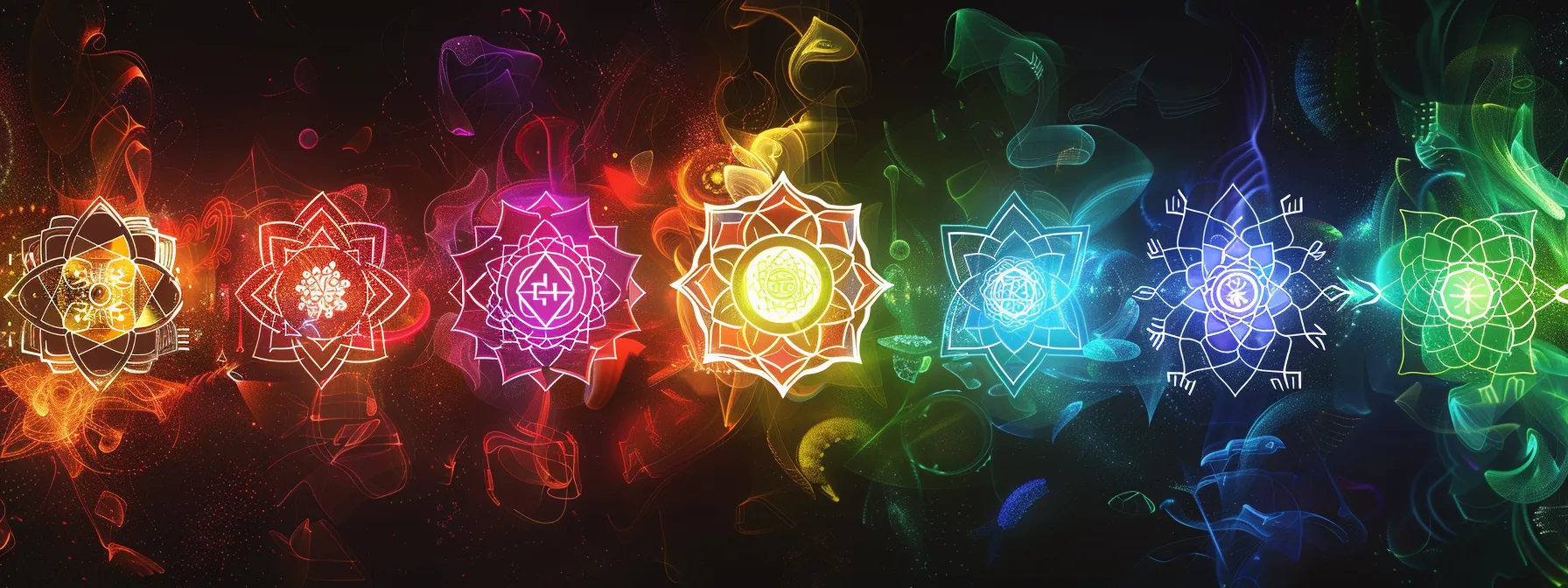
The seven major chakra icons each hold unique symbolism and significance that can enhance your understanding of energy flow within your body through the use of 7 chakra rudraksha. The Root Chakra (Muladhara) represents stability, while the Sacral Chakra (Svadhisthana) embodies creativity. The Solar Plexus Chakra (Manipura) signifies confidence, and the Heart Chakra (Anahata) symbolizes love. The Throat Chakra (Vishuddha) focuses on communication, the Third Eye Chakra (Ajna) relates to perception, and the Crown Chakra (Sahasrara) connects to spirituality. By exploring these symbols, you can gain insights into your personal growth and healing journey, as highlighted by experts like Anodea Judith and teachings from the Upanishads.
Root Chakra (Muladhara) Symbolism
The Root Chakra, or Muladhara, is foundational to your overall well-being, representing stability and security. Located at the base of your spine, near the sacrum, it connects you to the earth and the classical element of earth itself. When this chakra is balanced, you may feel grounded and secure, which is essential for your personal growth and development. Incorporating 7 chakra rudraksha can further enhance this balance.
This energy center is also linked to the awakening of kundalini energy, which lies dormant at the base of your spine. By focusing on the Root Chakra with 7 chakra rudraksha, you can facilitate the rise of this energy, promoting a sense of vitality and strength. Engaging in practices such as meditation or yoga can help you activate this chakra, enhancing your connection to your physical body and the world around you.
Understanding the symbolism of the Root Chakra can guide you in addressing feelings of fear or instability. When you nurture this energy center with the 7 chakra rudraksha, you create a solid foundation for the higher chakras, including the Anahata or Heart Chakra. This interconnectedness allows for a more harmonious flow of energy throughout your body, supporting your emotional and spiritual health.
Sacral Chakra (Svadhisthana) Symbolism
The Sacral Chakra, or Svadhisthana, is essential for your emotional and creative well-being. Located just below your navel, this chakra symbolizes the flow of energy related to pleasure, relationships, and creativity. When balanced, it allows you to experience joy and connection, while imbalances may lead to feelings of hatred or emotional instability, supported by 7 chakra rudraksha.
Engaging in practices such as hatha yoga and using 7 chakra rudraksha can help you activate and balance the Sacral Chakra. Specific mudras, or hand gestures, can also enhance your energy flow, promoting a sense of harmony and emotional clarity. By incorporating these practices into your routine, you can foster a deeper connection with your inner self and improve your overall emotional health.
Understanding the chakra symbolism of the Sacral Chakra can guide you in addressing emotional blockages. By recognizing the importance of this energy center, you can work towards releasing negative emotions and embracing creativity with 7 chakra rudraksha. This awareness empowers you to cultivate a fulfilling life, rich in emotional depth and personal expression:
Solar Plexus Chakra (Manipura) Symbolism
The Solar Plexus Chakra, known as Manipura in Sanskrit, is a vital energy center located in your upper abdomen. This chakra is associated with the glandular system, particularly the adrenal glands, which play a crucial role in your body’s response to stress. Understanding the significance of Manipura can empower you to harness your personal power and boost your confidence. Incorporating a 7 chakra rudraksha can enhance your energy balance.
This chakra resonates with a specific frequency that influences your self-esteem and willpower. When balanced, the Solar Plexus Chakra with 7 chakra rudraksha allows you to express your true self and make decisions with clarity. Engaging in practices such as meditation or breathwork can help you align with this energy center, enhancing your ability to take action in your life.
In Tibetan Buddhism, the Solar Plexus Chakra (7 chakra rudraksha) is often linked to the concept of personal transformation. By focusing on this chakra, you can address feelings of inadequacy or fear that may hold you back. Recognizing the importance of Manipura in your journey can lead to greater self-awareness and a more fulfilling life, as you learn to embrace your inner strength and potential.
Heart Chakra (Anahata) Symbolism
The Heart Chakra, or Anahata, is central to your emotional well-being and represents love, compassion, and connection. Located at the center of your chest, it serves as a bridge between the lower chakras, such as the navel or Sacral Chakra, and the higher chakras, including Ajna and Sahasrara. When balanced with 7 chakra rudraksha, this chakra allows you to experience deep emotional connections and fosters a sense of inner peace.
Understanding the symbolism of the Heart Chakra and 7 chakra rudraksha can help you navigate feelings of love and acceptance. It is associated with the element of air, which signifies freedom and openness. By focusing on this energy center with 7 chakra rudraksha, you can cultivate Shakti, or creative energy, that enhances your relationships and emotional health, allowing you to express your true self without fear.
To nurture your Heart Chakra, consider engaging in practices that promote self-love and compassion. Activities such as meditation, yoga, 7 chakra rudraksha, or even simple acts of kindness can help you open this energy center. By recognizing the importance of Anahata in your life, you can address feelings of isolation or emotional pain, leading to a more fulfilling and harmonious existence:
- Heart Chakra (Anahata) represents love and compassion.
- Located at the center of your chest, it connects lower and higher chakras.
- Engaging in self-love practices can enhance emotional well-being.
Throat Chakra (Vishuddha) Symbolism
The Throat Chakra, known as Vishuddha, is essential for effective communication and self-expression. Located in the throat area, this chakra influences your ability to articulate thoughts and feelings clearly. When balanced, you may find it easier to express your ideas and connect with others, fostering deeper relationships and understanding. Incorporating 7 chakra rudraksha can enhance this balance.
Engaging in practices such as meditation using 7 chakra rudraksha can help you activate and balance the Throat Chakra. By focusing on this energy center, you can enhance your confidence in speaking and sharing your truth. This process not only improves your communication skills but also strengthens your faith in your own voice and perspective.
Recognizing the significance of the Throat Chakra can guide you in addressing any communication barriers you may face. If you struggle with expressing yourself, consider incorporating vocal exercises, journaling, or the use of 7 chakra rudraksha into your routine. These practices can empower you to overcome obstacles, allowing for a more authentic and fulfilling expression of your thoughts and emotions.
Third Eye Chakra (Ajna) Symbolism
The Third Eye Chakra, known as Ajna, is often associated with intuition and perception. This chakra is linked to the organ of sight and is believed to enhance your ability to see beyond the physical realm. By focusing on this energy center with 7 chakra rudraksha, you can tap into higher vibrations that promote clarity and insight, allowing you to connect with your inner wisdom.
In Buddhism, the Third Eye Chakra is considered a gateway to spiritual awakening and enlightenment. Engaging in practices such as yoga nidra and using 7 chakra rudraksha can help you activate this chakra, facilitating a deeper understanding of your thoughts and emotions. This connection to the divine can empower you to navigate life’s challenges with greater awareness and purpose.
The symbolism of Ajna also includes the representation of a deity with 7 chakra rudraksha, which signifies the importance of spiritual guidance in your journey. By recognizing the significance of the Third Eye Chakra and incorporating 7 chakra rudraksha, you can cultivate a stronger sense of self and enhance your decision-making abilities. This awareness can lead to a more fulfilling life, as you learn to trust your intuition and embrace your unique path.
Crown Chakra (Sahasrara) Symbolism
The Crown Chakra, or Sahasrara, is the highest energy center in your body, located at the top of your head. This chakra is often associated with the color violet, symbolizing spiritual enlightenment and connection to the divine. When balanced with 7 chakra rudraksha, the Crown Chakra allows you to experience a profound sense of peace and unity with the universe, enhancing your overall healing journey.
In Hindu texts, the Crown Chakra is linked to the concept of spiritual force, representing the culmination of your personal growth and self-awareness. It serves as a gateway to higher consciousness, allowing you to tap into the universal energy that flows through your spinal cord. By focusing on this chakra with the use of 7 chakra rudraksha, you can cultivate a deeper understanding of your purpose and enhance your spiritual practices.
Engaging with the symbolism of the Crown Chakra can empower you to overcome feelings of isolation and disconnection. You may find that meditation and mindfulness practices help you activate this energy center with 7 chakra rudraksha, promoting healing and a sense of belonging. By nurturing your Sahasrara, you can unlock your full potential and embrace a more fulfilling life:
The colors of the chakra icons tell their own stories. Understanding these hues deepens your connection to their meanings and power.
Color Significance in Chakra Icons
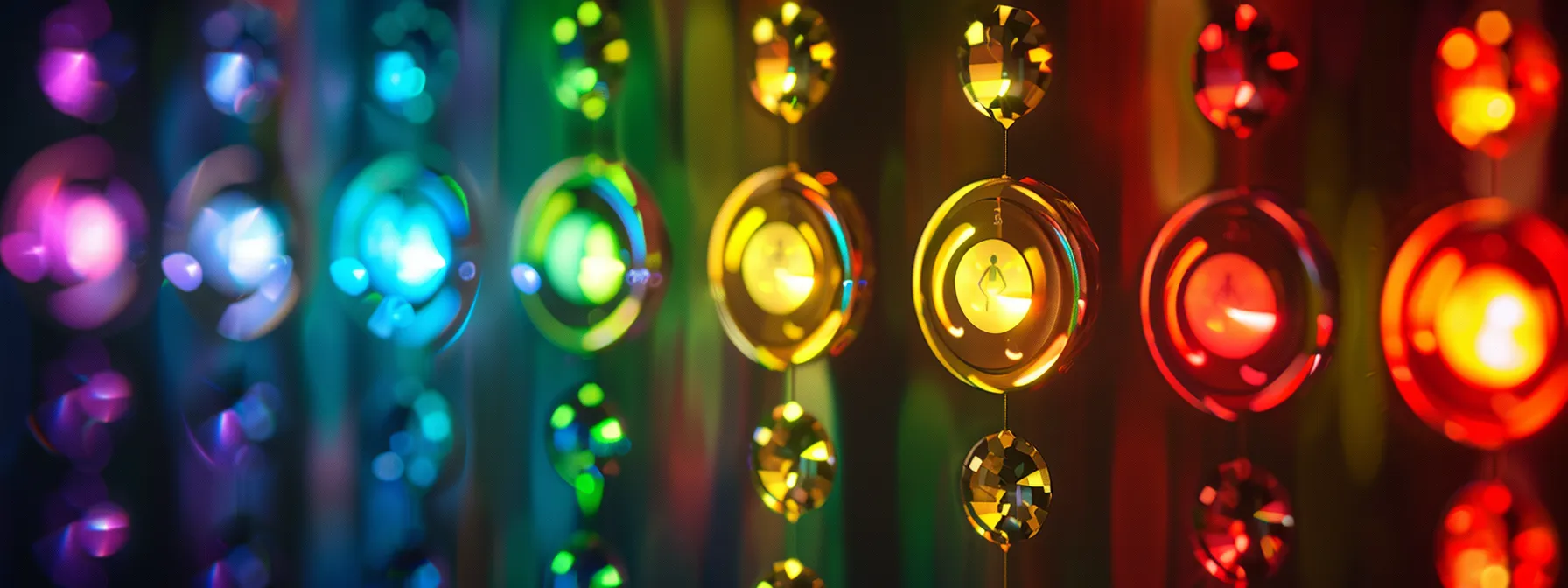
The colors associated with each chakra icon and the 7 chakra rudraksha hold significant meaning in Indian philosophy, influencing your emotional and spiritual well-being. Red represents stability in the Root Chakra, while orange embodies pleasure in the Sacral Chakra. Yellow signifies confidence in the Solar Plexus Chakra, and green reflects love in the Heart Chakra. Blue enhances communication in the Throat Chakra, indigo promotes intuition in the Third Eye Chakra, and violet symbolizes spiritual enlightenment in the Crown Chakra. Understanding these colors can deepen your connection to each chakra and support your journey toward moksha.
Red in Root Chakra Symbol
The color red in the Root Chakra 7 chakra rudraksha symbol is deeply connected to your emotions and sense of stability. This vibrant hue represents the foundational aspects of your being, grounding you in the present moment. By focusing on the Root Chakra 7 chakra rudraksha, you can enhance your emotional resilience, allowing you to navigate life’s challenges with greater ease.
Engaging in practices such as breathwork can help you activate the energy of the Root Chakra with 7 chakra rudraksha. As you breathe deeply, visualize the red energy flowing through your astral body, reinforcing your connection to the earth and your sense of security. This practice not only promotes emotional balance but also fosters a deeper understanding of your own divinity.
The teachings of the Bhagavad Gita emphasize the importance of grounding oneself in the physical realm to achieve spiritual growth. By recognizing the significance of the red color in the Root Chakra and incorporating 7 chakra rudraksha, you can cultivate a stronger foundation for your personal development. This awareness empowers you to embrace your emotions and build a life rooted in stability and strength.
Orange in Sacral Chakra Symbol
The color orange in the Sacral Chakra symbol is closely linked to the concept of happiness and emotional well-being. This vibrant hue represents creativity, pleasure, and the joy of living. By focusing on the Sacral Chakra, you can enhance your ability to experience inner peace and cultivate fulfilling relationships, which are essential for a balanced life. Incorporating 7 chakra rudraksha can further support your emotional well-being.
Incorporating the principles of sacred geometry and 7 chakra rudraksha into your understanding of the Sacral Chakra can deepen your connection to this energy center. The circular shape often associated with this chakra reflects the flow of energy and the cyclical nature of life. Engaging with this symbolism can help you embrace your creative potential and foster a sense of harmony within yourself.
The Vedas emphasize the importance of emotional balance and self-expression, which are embodied in the Sacral Chakra with 7 chakra rudraksha. By recognizing the significance of the orange color, you can work towards releasing emotional blockages and inviting joy into your life. This awareness empowers you to create a more vibrant and fulfilling existence, allowing you to connect with your true self and the world around you.
Yellow in Solar Plexus Chakra Symbol
The color yellow in the Solar Plexus Chakra symbol represents intellect and personal power. This vibrant hue is associated with the qualities of clarity and confidence, which are essential for effective decision-making. By focusing on this chakra and using 7 chakra rudraksha, you can enhance your ability to express your thoughts and ideas, fostering a deeper connection to your inner wisdom.
Incorporating the philosophy of the Solar Plexus Chakra and 7 chakra rudraksha into your daily practices can empower you to overcome self-doubt and embrace your true potential. As you engage with this energy center, you may find that your communication improves, particularly in relation to the Throat Chakra. This connection allows you to articulate your thoughts with greater ease, enhancing your interactions with others.
As a yogini, you can utilize the energy of the Solar Plexus Chakra to cultivate a sense of self-worth and confidence. Engaging in practices such as meditation or affirmations focused on this chakra or using 7 chakra rudraksha can help you tap into your inner strength. By recognizing the significance of yellow in this context, you can unlock the wisdom needed to navigate life’s challenges with assurance and clarity.
Green in Heart Chakra Symbol
The color green in the Heart Chakra symbol represents compassion and emotional balance. This vibrant hue is essential for fostering connections with others and nurturing your relationships. When you focus on the Heart Chakra using 7 chakra rudraksha, you can enhance your ability to express love and empathy, which are vital for personal growth and emotional well-being.
In the context of tantra, the Heart Chakra serves as a bridge between the lower and higher energy centers, allowing you to connect with your ātman, or true self using 7 chakra rudraksha. By understanding the significance of green, you can cultivate a deeper sense of self-acceptance and compassion for others. This awareness empowers you to navigate your emotional landscape with greater ease, promoting harmony in your interactions.
To activate the energy of the Heart Chakra, consider engaging in practices such as 7 chakra rudraksha that encourage emotional openness and vulnerability. Activities such as meditation, yoga, or even simple acts of kindness can help you connect with the green energy of this chakra. By nurturing your Heart Chakra, you can enhance your instinct for compassion and create a more fulfilling life:
- Green symbolizes compassion and emotional balance.
- It connects you to your true self (ātman) through the Heart Chakra.
- Engaging in practices like meditation can activate this energy center.
Blue in Throat Chakra Symbol
The blue color in the Throat Chakra symbol, known as Vishuddha, plays a crucial role in your ability to communicate effectively. This chakra is associated with self-expression and clarity, allowing you to articulate your thoughts and feelings with confidence. By focusing on the blue energy of this chakra and using 7 chakra rudraksha, you can enhance your communication skills, which is essential for personal and professional relationships.
In the context of yoga teacher training, understanding the significance of the Throat Chakra and 7 chakra rudraksha can deepen your practice and teaching. The yoga sutras of Patanjali emphasize the importance of clear communication in achieving personal growth and spiritual development. By nurturing the blue energy of Vishuddha, you can connect more profoundly with your students and foster an environment of open dialogue and understanding.
The Throat Chakra is often depicted with a petal design, symbolizing the blossoming of your voice and expression. Engaging in practices that activate this chakra, such as chanting or breathwork, can help you overcome barriers to communication. By recognizing the importance of the blue color in this chakra and using 7 chakra rudraksha, you empower yourself to express your truth and connect with others on a deeper level.
Indigo in Third Eye Chakra Symbol
The indigo color in the Third Eye Chakra symbol, known as Ajna, represents a deep connection to consciousness and intuition. This chakra is crucial for enhancing your perception and understanding of the world around you. By focusing on the meaning of chakra symbols, particularly the indigo hue and 7 chakra rudraksha, you can unlock insights that guide your personal and spiritual growth.
In Rishikesh, a hub for spiritual practices, the Third Eye Chakra is often emphasized in therapy sessions aimed at improving mental clarity and emotional balance. Engaging with the indigo energy and using 7 chakra rudraksha can help you tap into your inner wisdom, allowing you to make decisions that align with your true self. This connection fosters a sense of empowerment, enabling you to navigate life’s challenges with greater confidence.
Understanding the significance of the indigo color in the Third Eye Chakra can enhance your overall well-being. By incorporating practices that activate this chakra, such as meditation, mindfulness, or using 7 chakra rudraksha, you can cultivate a deeper awareness of your thoughts and feelings. This awareness not only supports your journey toward self-discovery but also enriches your interactions with others, promoting clearer communication and understanding, much like the principles of Vishuddha, the Throat Chakra.
Violet in Crown Chakra Symbol
The violet color in the Crown Chakra symbol, or Sahasrara, represents spiritual enlightenment and a deep connection to the universe. This chakra with 7 chakra rudraksha, located at the top of your head, is essential for achieving a state of awareness that transcends the physical realm. By focusing on this energy center, you can enhance your psychic abilities and cultivate a greater understanding of your dharma, or life purpose.
In practices like kundalini yoga, activating the Crown Chakra with a 7 chakra rudraksha is vital for experiencing the full spectrum of spiritual growth. When you engage with the violet energy, you may find that it opens pathways to higher consciousness, allowing you to explore concepts such as śūnyatā, or emptiness. This understanding can lead to profound insights about your existence and the interconnectedness of all beings.
As you work to balance the Crown Chakra, consider incorporating 7 chakra rudraksha meditation techniques that emphasize the violet hue. This practice can help you tap into your inner wisdom and foster a sense of unity with the universe. By nurturing this energy center with 7 chakra rudraksha, you empower yourself to navigate life’s challenges with clarity and purpose, ultimately enhancing your spiritual journey.
The colors in chakra icons tell a story of their own. Next, we will explore how the shapes and elements deepen that narrative, revealing even more about their meaning.
Interpreting Shapes and Elements in Chakra Icons
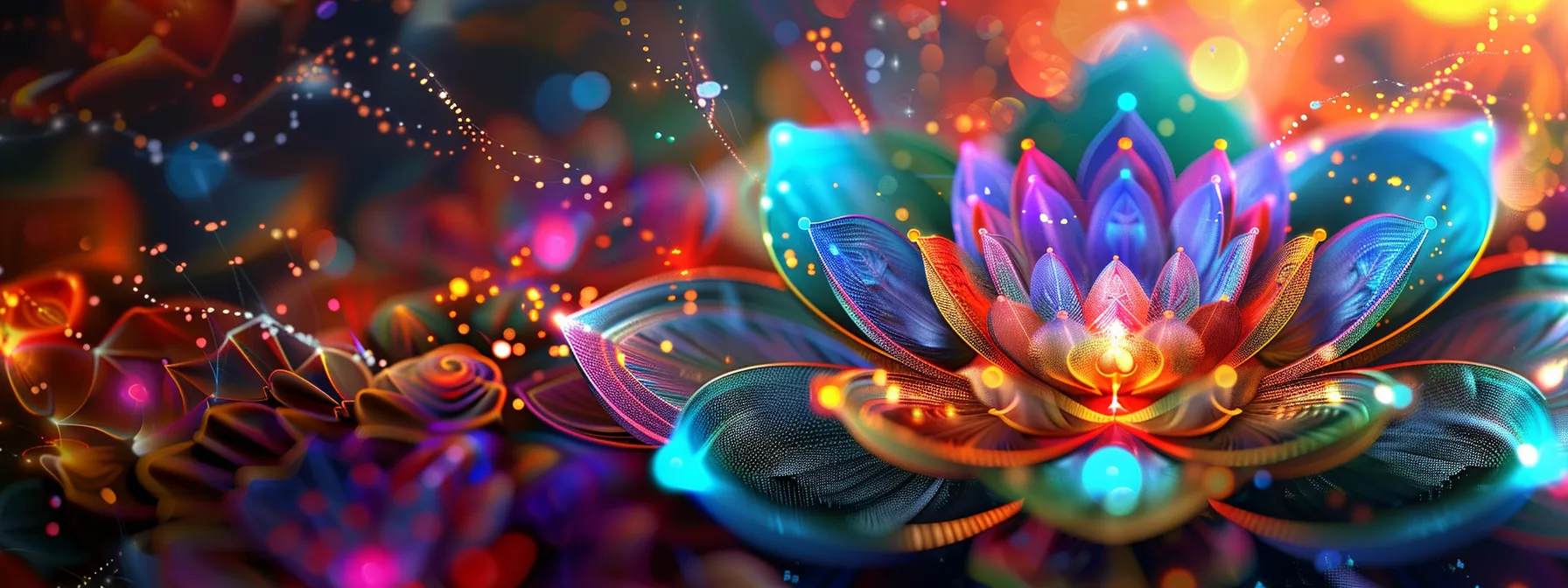
Chakra icons incorporate various shapes and elements such as 7 chakra rudraksha that hold significant meaning. The use of lotuses in chakra symbols represents purity and spiritual awakening. Geometric patterns convey deeper truths about energy flow, while the symbolism of petals and their numbers reflects specific qualities of each chakra. Additionally, animal symbols and the connection between elements and chakras enhance your understanding of these energy centers. Exploring these aspects will provide you with practical insights into how imagination and culture influence your spiritual practices, including pranayama and breathing techniques.
The Use of Lotuses in Chakra Symbols
The lotus flower holds a significant place in Hindu philosophy, symbolizing purity and spiritual awakening. Each chakra is often depicted with a lotus and 7 chakra rudraksha, reflecting the idea that as you progress through your spiritual journey, you can rise above challenges and attain higher states of consciousness. By understanding the connection between the lotus and chakra colors symbols, you can deepen your appreciation for the transformative power of these energy centers.
In the context of chakra healing, the lotus also represents the unfolding of your potential, much like the petals of the flower opening to the sun. This imagery aligns with the concept of nadi, or energy channels, which facilitate the flow of prana, or life force, throughout your body. By focusing on the lotus symbolism and using 7 chakra rudraksha, you can enhance your meditation practices, incorporating mantras that resonate with each chakra to promote balance and harmony with 7 chakra rudraksha.
As you explore the significance of the lotus in chakra symbols such as 7 chakra rudraksha, consider how it relates to the concept of kama, or desire. The lotus encourages you to cultivate your desires in a way that aligns with your higher self, guiding you toward fulfillment and purpose. By engaging with this symbolism, you can unlock deeper insights into your emotional and spiritual well-being, fostering a more profound connection to your inner self and the world around you.
Geometric Patterns and Their Meanings
Geometric patterns in chakra icons serve as visual representations of the energy flow within your body. Each shape, whether it be a triangle or a circle, holds specific meanings that can enhance your understanding of the chakras. For instance, the triangle often symbolizes the element of fire, which is associated with transformation and personal power, while circles represent unity and wholeness, inviting you to focus your attention on achieving balance in your life with the help of 7 chakra rudraksha.
When you engage with these geometric patterns, you may find that they resonate with your feelings and experiences. The intricate designs can evoke a sense of calm and clarity, helping you to connect with your inner self through the 7 chakra rudraksha. For example, the lotus shape, often linked to the goddess Lakshmi, embodies prosperity and spiritual growth, encouraging you to cultivate a mindset that attracts abundance and well-being.
Understanding the significance of these geometric patterns can also improve your overall well-being, including your sleep quality. By incorporating meditation practices such as 7 chakra rudraksha that focus on these shapes, you can create a calming environment that promotes relaxation and mindfulness. This approach not only enhances your spiritual journey but also empowers you to navigate life’s challenges with greater ease, much like the teachings of Brahma emphasize the importance of awareness and intention in your daily life.
Symbolism of Petals and Their Numbers
The number of petals in chakra symbols holds significant meaning, reflecting the qualities and attributes associated with each energy center. For instance, the Heart Chakra (Anahata) is often depicted with twelve petals, symbolizing love, compassion, and emotional balance. Understanding these petal counts can enhance your awareness of how each chakra influences your mind and emotional state, guiding you toward personal growth. Incorporating 7 chakra rudraksha can further support the alignment and balance of your energy centers.
In Ayurveda, the petals of chakra symbols and 7 chakra rudraksha are linked to various aspects of health and well-being. Each petal represents a specific quality or virtue that can be cultivated through focused practices. By recognizing the symbolism of petals, you can better align your energy with the desired qualities, such as creativity in the Sacral Chakra or clarity in the Throat Chakra, ultimately supporting your journey toward holistic health.
As you explore the chakra symbols and meaning, including 7 chakra rudraksha, consider how the petal counts resonate with your personal experiences. Engaging with these symbols can deepen your understanding of your emotional landscape and empower you to address any imbalances. By focusing on the qualities represented by the petals, you can enhance your mindfulness practices and foster a greater sense of harmony in your life:
Incorporation of Animal Symbols
Animal symbols play a significant role in the interpretation of chakra icons, such as 7 chakra rudraksha, as they often embody specific qualities and attributes that resonate with your spiritual journey. For instance, the elephant is commonly associated with the Root Chakra, symbolizing strength and stability. By understanding these animal representations, you can enhance your empathy and connection to the energy centers within your body.
The incorporation of animal symbols also extends to the Third Eye Chakra, where the owl is frequently depicted. This bird represents insight and wisdom, guiding you toward deeper understanding and awareness. Engaging with these symbols and 7 chakra rudraksha can help you cultivate your intuition, allowing you to navigate life’s complexities with greater clarity and purpose.
Connection Between Elements and Chakras
The connection between elements and chakras is fundamental in understanding how these energy centers influence your mental state and overall well-being. Each chakra corresponds to a specific element, such as earth, water, fire, air, and space, which shapes its unique qualities and functions. For instance, the Root Chakra is associated with the earth element, grounding you in reality and providing stability, while the Throat Chakra connects to the element of ether, enhancing your ability to communicate and express your truth.
In Hinduism, the elements play a crucial role in the teachings of the sutras, guiding you toward a deeper understanding of your inner self. By recognizing how each chakra interacts with its corresponding element, you can harness their energies to improve your intuition and emotional balance. For example, engaging with the water element through practices like meditation can help you flow with your emotions, promoting clarity and insight in your daily life.
Understanding the relationship between elements and chakras empowers you to create a more harmonious existence. By focusing on the specific qualities of each element, you can address imbalances in your energy centers and enhance your personal growth. This awareness allows you to navigate life’s challenges with greater ease, ultimately leading to a more fulfilling and connected experience:
The shapes and colors of chakra icons hold deeper meanings. Understanding these symbols reveals how they can influence your energy and promote healing.
How Chakra Symbols Influence Energy and Healing

Chakra symbols play a crucial role in influencing your energy and healing practices. Visual meditation with chakra icons can enhance your focus and promote relaxation, while aligning your energy centers using these symbols helps balance your nervous system. In Reiki and energy work, chakra symbols serve as powerful tools for channeling healing energy. Additionally, incorporating these symbols into your mindfulness practices can deepen your self-awareness and connection to your inner self, enhancing your overall well-being.
Visual Meditation With Chakra Icons
Visual meditation with chakra icons can significantly enhance your energy and healing practices. By focusing on these symbols during meditation, you create a mental space that allows you to connect with the specific qualities associated with each chakra. This practice not only promotes relaxation but also helps you align your energy centers, leading to a more balanced state of being.
As you engage in visual meditation, consider incorporating the colors and shapes of chakra symbols into your practice. For example, visualizing the vibrant red of the Root Chakra can ground you, while the soothing green of the Heart Chakra can foster feelings of love and compassion. This intentional focus on chakra icons can deepen your self-awareness and enhance your emotional well-being.
To maximize the benefits of visual meditation, set aside dedicated time in a quiet space where you can concentrate without distractions. You might find it helpful to use guided meditations that incorporate chakra symbols, allowing you to explore their meanings and significance more deeply. By making this practice a regular part of your routine, you can unlock the healing potential of chakra icons and support your personal growth journey.
Aligning Energy Centers Using Symbols
Aligning your energy centers using chakra symbols can significantly enhance your overall well-being. By focusing on specific symbols during meditation or mindfulness practices, you can direct your attention to the qualities associated with each chakra. This intentional alignment helps to clear blockages and promote a balanced flow of energy throughout your body.
Incorporating chakra symbols into your daily routine can also serve as a powerful reminder of your personal growth journey. For example, visualizing the symbol of the Heart Chakra can encourage feelings of love and compassion, while the Root Chakra symbol can ground you in stability. By regularly engaging with these symbols, you can reinforce your intentions and support your emotional and spiritual health.
To effectively align your energy centers, consider creating a dedicated space for your chakra practices. This space can include visual representations of the chakra symbols, such as artwork or crystals, that resonate with you. By surrounding yourself with these symbols, you create an environment that fosters healing and encourages a deeper connection to your inner self:
Chakra Symbols in Reiki and Energy Work
Chakra symbols play a vital role in Reiki and energy work, serving as powerful tools for channeling healing energy. When you focus on these symbols during a Reiki session, you can enhance your ability to direct energy toward specific chakras, promoting balance and healing. This intentional use of chakra symbols allows you to address emotional and physical blockages, facilitating a smoother flow of energy throughout your body.
Incorporating chakra symbols into your energy work can deepen your understanding of the unique qualities associated with each energy center. For example, visualizing the Heart Chakra symbol can help you cultivate feelings of love and compassion, while focusing on the Solar Plexus Chakra symbol can empower you to boost your confidence. By engaging with these symbols, you can create a more effective healing experience that resonates with your personal growth journey.
As you explore the integration of chakra symbols in your Reiki practice, consider creating a dedicated space that reflects these energy centers. This space can include visual representations of the chakra symbols, such as artwork or crystals, that resonate with you. By surrounding yourself with these symbols, you enhance your connection to the healing process and support your overall well-being:
- Chakra symbols enhance energy flow in Reiki.
- Visualizing symbols promotes emotional and physical healing.
- Creating a dedicated space for chakra symbols supports personal growth.
Enhancing Mindfulness Through Symbolism
Enhancing mindfulness through chakra symbolism can significantly improve your overall well-being. By focusing on the specific symbols associated with each chakra, you can cultivate a deeper awareness of your emotional and physical states. This practice allows you to identify areas of imbalance and work towards restoring harmony in your life.
Incorporating chakra symbols into your daily mindfulness practices can help you stay grounded and present. For instance, visualizing the Root Chakra symbol during meditation can reinforce feelings of stability and security. This intentional focus not only promotes relaxation but also encourages a stronger connection to your inner self, guiding you toward personal growth.
As you engage with chakra symbols, consider how they resonate with your experiences and emotions. By reflecting on the qualities associated with each chakra, you can gain insights into your needs and aspirations. This understanding empowers you to take actionable steps toward enhancing your mindfulness, ultimately leading to a more balanced and fulfilling life.
Chakra symbols hold power, but their true strength lies in how you use them. Discovering ways to weave these icons into your daily life can deepen your connection to their energy and enhance your healing journey.
Incorporating Chakra Icons Into Daily Practice
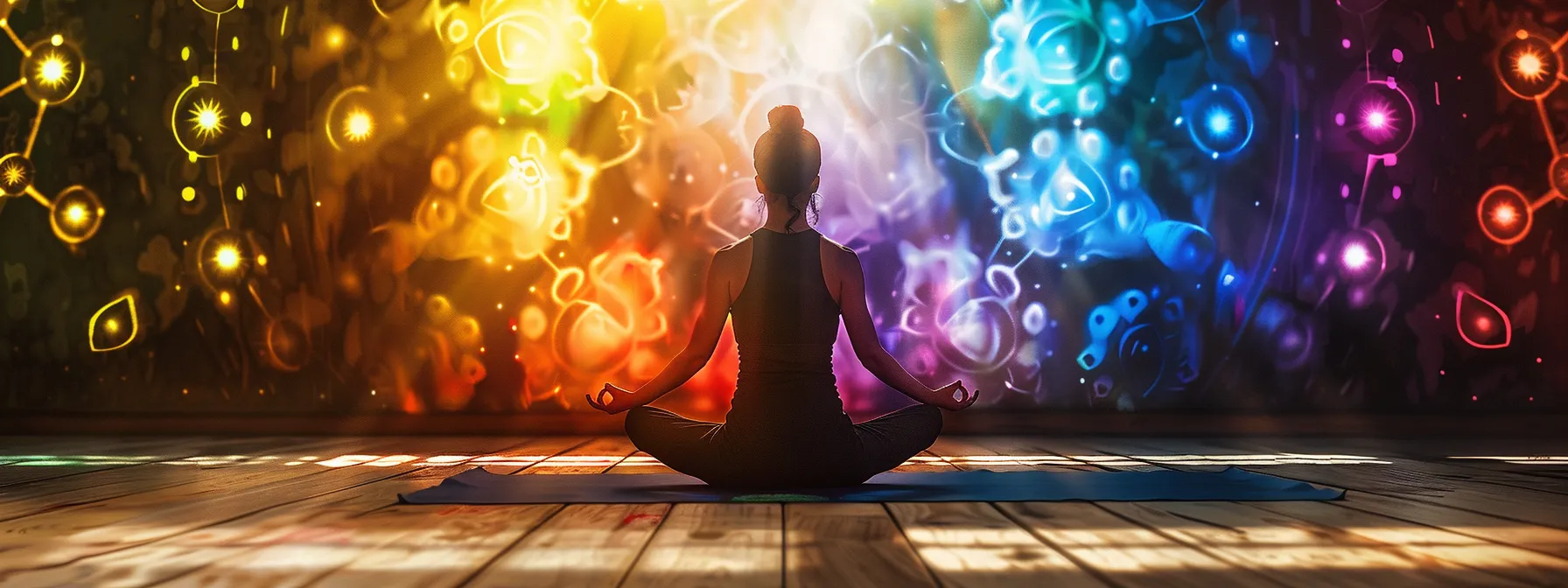
Incorporating chakra icons into your daily practice can enhance your spiritual journey and personal growth. You can use chakra symbols in yoga to deepen your connection with each energy center. Decorating your spaces with chakra imagery creates a harmonious environment, while personal reflection and journaling with these symbols promote self-awareness. Creating art inspired by chakra icons allows for creative expression, and wearing chakra symbols as jewelry serves as a constant reminder of your intentions. Each of these practices offers practical insights to support your well-being and spiritual development.
Using Chakra Symbols in Yoga
Using chakra symbols in your yoga practice can significantly enhance your connection to each energy center. As you move through various poses, visualize the corresponding chakra symbol to deepen your focus and intention. For example, while practicing grounding poses like Mountain Pose, envision the square symbol of the Root Chakra to reinforce feelings of stability and security.
Incorporating chakra symbols into your yoga routine allows you to align your physical movements with your emotional and spiritual goals. You can chant the sound associated with each chakra while holding a pose, such as “Yam” for the Heart Chakra, to promote love and compassion. This practice not only enriches your yoga experience but also helps you cultivate a greater sense of awareness and balance in your life.
As you explore the integration of chakra symbols in yoga, consider creating a dedicated space for your practice that features these icons. Surrounding yourself with visual representations of the chakras can serve as a constant reminder of your intentions and aspirations. By making this connection, you empower yourself to navigate your personal growth journey with clarity and purpose.
Decorating Spaces With Chakra Imagery
Decorating your spaces with chakra imagery can create an environment that promotes balance and harmony in your life. By incorporating symbols that represent each chakra, you can enhance your awareness of these energy centers and their significance. For instance, placing a vibrant representation of the Heart Chakra in your living room can foster feelings of love and compassion, making it a welcoming space for family and friends.
Consider using chakra-themed artwork, wall hangings, or decorative items that resonate with you. These visuals not only beautify your space but also serve as constant reminders of your intentions and personal growth. You might choose to display a colorful mandala that represents the Solar Plexus Chakra in your workspace to boost your confidence and motivation throughout the day.
As you curate your environment, think about how each chakra symbol can influence your emotional state. By strategically placing these icons in areas where you spend the most time, you can create a supportive atmosphere that encourages mindfulness and self-reflection. Here are some practical ways to incorporate chakra imagery into your daily life:
- Use chakra-themed artwork to enhance your meditation space.
- Incorporate colored cushions or throws that represent each chakra in your living area.
- Display crystals associated with specific chakras on your desk or shelves.
- Hang wall art that features chakra symbols in your bedroom to promote restful sleep.
Personal Reflection and Journaling With Symbols
Engaging in personal reflection and journaling with chakra symbols can significantly enhance your self-awareness and emotional clarity. By dedicating time to write about your experiences and feelings related to each chakra, you can uncover insights that may have previously gone unnoticed. This practice allows you to connect deeply with the symbolism of each chakra, fostering a greater understanding of how they influence your daily life.
As you journal, consider focusing on specific chakra symbols and their associated qualities. For instance, if you are exploring the Heart Chakra, reflect on your feelings of love and compassion, and how they manifest in your relationships. This targeted approach not only helps you identify areas for growth but also empowers you to set intentions for personal development, guiding you toward a more balanced and fulfilling life.
Incorporating chakra symbols into your journaling practice can also serve as a powerful tool for healing. By expressing your thoughts and emotions related to each energy center, you can address any blockages or imbalances you may be experiencing. This process of self-exploration can lead to transformative insights, enabling you to cultivate a deeper connection with your inner self and enhance your overall well-being.
Creating Art Inspired by Chakra Icons
Creating art inspired by chakra icons can be a powerful way to deepen your connection with these energy centers. By expressing the unique symbolism of each chakra through painting, drawing, or crafting, you can enhance your understanding of their significance in your life. This creative process not only allows for personal expression but also serves as a therapeutic outlet, helping you to explore your emotions and intentions.
As you engage in this artistic practice, consider using the colors and shapes associated with each chakra to guide your creations. For example, you might choose vibrant reds and earthy shapes for the Root Chakra, or soothing greens and floral designs for the Heart Chakra. This approach can help you focus on the qualities you wish to cultivate, such as stability, love, or creativity, making your artwork a reflection of your personal growth journey.
Incorporating chakra symbols into your art can also serve as a daily reminder of your intentions and aspirations. Displaying your creations in your living space can create an environment that promotes mindfulness and balance. By surrounding yourself with these visual representations, you reinforce your commitment to personal development and enhance your overall well-being:
Wearing Chakra Symbols as Jewelry
Wearing chakra symbols as jewelry serves as a powerful reminder of your intentions and personal growth. Each piece can represent a specific chakra, allowing you to carry its energy with you throughout your day. For instance, a necklace featuring the Heart Chakra symbol can encourage feelings of love and compassion, helping you navigate your relationships with greater ease.
Incorporating chakra jewelry into your daily routine can enhance your connection to these energy centers. As you wear these symbols, you may find that they inspire mindfulness and self-reflection. This practice not only promotes emotional balance but also reinforces your commitment to personal development, guiding you toward a more harmonious existence.
Choosing chakra jewelry that resonates with you can also be a form of self-expression. Whether you prefer bracelets, earrings, or pendants, each piece can reflect your unique journey and aspirations. By selecting jewelry that aligns with your goals, you empower yourself to embrace the qualities associated with each chakra, ultimately supporting your overall well-being.



